VEILED CHAMELEON CARE SHEET
Chamaeleo calyptratus
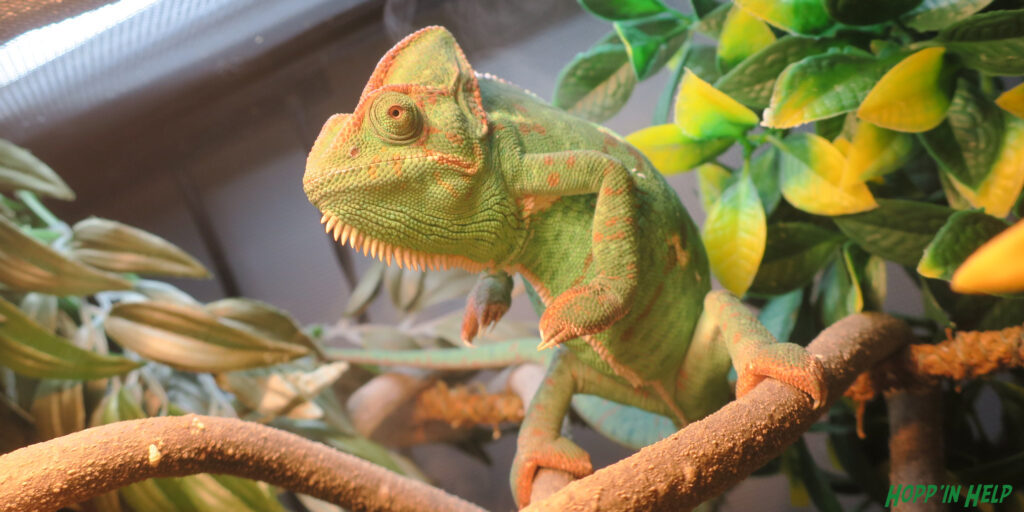
PERSONAL EXPERIENCE: Veiled Chameleons are such amazing and interesting creatures to work with. While they are extremely cool, they also require very intricate and precise care. They are delicate creatures and even in the best conditions, they still can face many health issues. In my personal opinion, Veiled Chameleons are not a species for beginner or intermediate reptile owners. They are also not a species that enjoys being handled. It is very rare to find a chameleon with a friendly personality and handling can cause unnecessary stress. Rather enjoy their display of colors from afar!
CAPTIVITY DIFFICULTY: Advanced
LIFE SPAN: 5-15 years
ACTIVITY: Veiled Chameleons are diurnal, meaning they are active in the daytime. They spend their days basking, drinking water from dripping leaves, exploring their enclosure, and looking for food. Or they can sit by their food dish and beg all day like my chameleon. At night your chameleon will find a comfy perch and snuggle down to sleep. You may notice they look like a leaf on a branch when asleep. This is their camouflage!
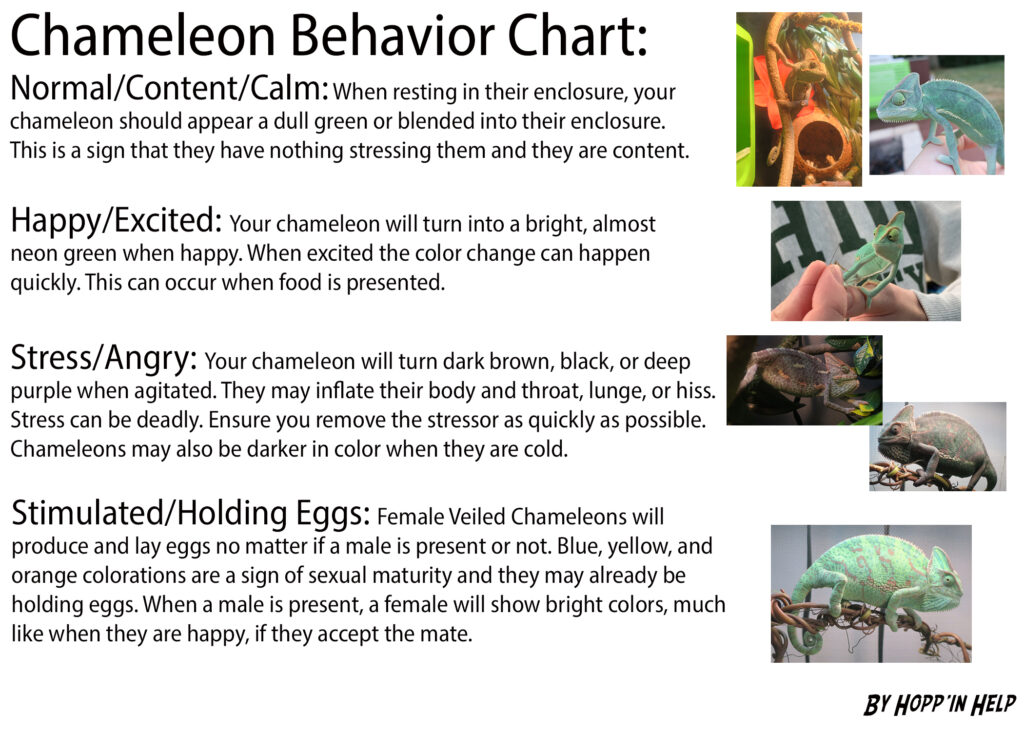
ENCLOSURE: Creating a Veiled Chameleon enclosure takes time and patience. Building these enclosures is a process, not just simply placing items and being done with it quickly. I will be explaining how to create an enclosure for a mesh tank. I begin first with structural “sticks”. These are textured, wooden rods that I poke through both sides of the enclosure to create a sturdy base for the vines. Avoid slippery surfaces with your vase sticks or climbing vines. Mossy vines or stakes may be used. The branches along with other key supplies I use will be linked below on buttons. I use these sticks to create a foundation for vines and foliage. I place them at different levels of the enclosure, piercing them through the sides of the enclosure to ensure they are safely fastened. I then reinforce the stakes on the outside of the enclosure with rubber bands. Think of the rubber bands as a bolt. Keep in mind, Branches should be placed at least 6 inches (15cm) below the UVB bulb which will rest on the top of your enclosure as the first few inches of light are very strong. Be sure to remember this information when setting up your enclosure. I then take pliable vines and weave them between the secured sticks to create “walkways” and areas for the chameleon to sleep and rest. Have resting points at different levels, this allows your chameleon to bask at different temperatures. Ensure your chameleon can reach each vine, falls can be devastating to their fragile bodies.
Next comes creating cover with foliage. Veiled Chameleons thrive with live plants. I personally suggest having a primary large plant potted in the bottom of the enclosure that extends through out the space. Veiled Chameleon safe plants include; Umbrella Plant, Weeping Fig, and Hibiscus Trees, Devils Ivy, Lipstick Plant, Yucca, and Rubber Trees. To prepare your live plants, please click the button below for a detailed video.
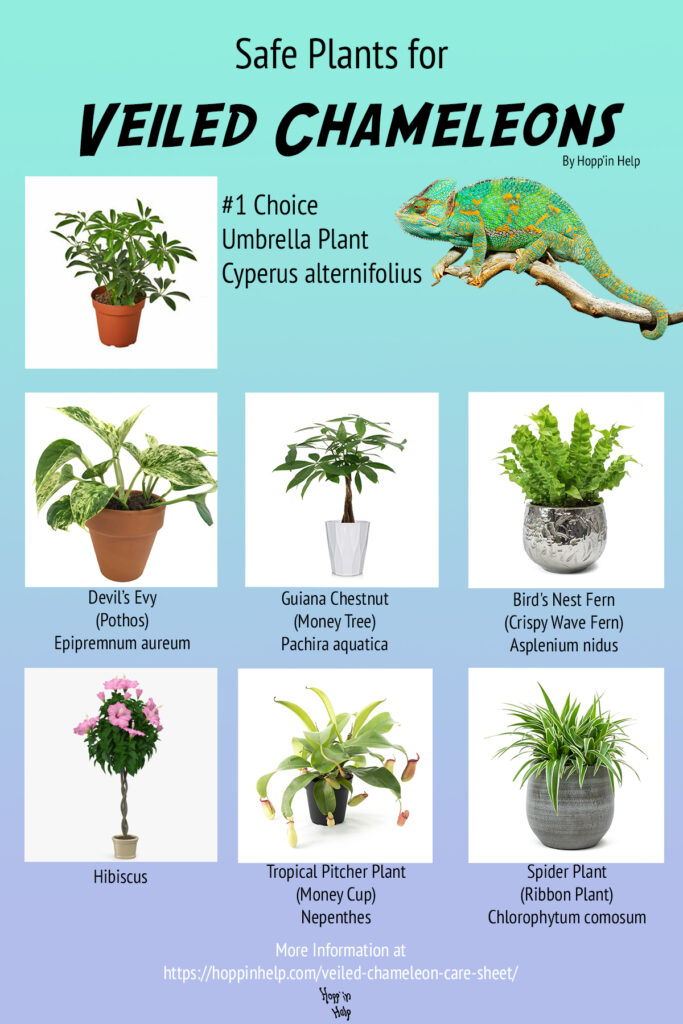
For more live plants, their benefits, and what to avoid, click the link below.
False plants are not directly harmful to your chameleon but may cause health issues. Veiled Chameleons may occasionally snack on a leaf or two and plastic pieces can cause impactions. The only time using false plants can be beneficial is for rescued chameleons with health conditions that may cause them to wobble or be a fall risk. False plants make good “cushions” or guard rails for chameleons while they heal. However these are very specific situations that should be assed with a vet before implementing.
Veiled Chameleons only drink dripping water, a water bowl is not needed. A drip system must be used. I personally have had the best experience with Fluker’s Reptile Drip System. It is the most reliable, easiest to keep clean, and easiest to refill. I have had a bad experience with electric drippers as they clog, make loud stressful noises, and get dirty very quickly.
HUMIDITY: Humidity is another crucial aspect of your chameleon’s life. A fogger system is needed to maintain proper humidity levels. Daytime humidity should sit around 30-40%. Light misting with a spray bottle or short burst from your fogger can be used to maintain the humidity if the room does not commonly sit in that range. It is important to not make it too humid while the basking light is on (day time). Hot temperatures and humidity can easily cause respiratory issues. This is a common issue in enclosed enclosures with little air flow. This is why I personally recommend open air screen enclosures. In my room full of exotic species, I only mist in the morning and evening, as the humidity naturally sits in the 30-40% range.
At night, humidity should be 80-100%. My schedule goes as the following: Lights on 8am-8pm. Misting around these times. Humidifier runs 9pm-6am straight. I used to only run the humidifier in hour increments but saw an improvement in health with running the humidifier all night.
I have had a great experience with the Reptile Humidifier by Evergreen Pet Supplies. I purchased mine in 2017 and it is still working great. A suggestion is to use distilled water for fogger systems to prolong the systems life and clean all pieces regularly. All tap water used for your chameleon must be treated with water conditioner to remove harmful chemicals.
Something that is not needed but I enjoy is a special “bowl” for feeders. It is called a Shooting Gallery by TK Chameleons. It is a specialized window that you place your feeders in. This helps you determine how much your chameleon is eating and ensures no uneaten crickets are agitating your chameleon.
ENCLOSURE SIZE: Chameleons require a mesh enclosure for proper airflow. Strictly glass enclosures are not suitable for chameleons.
0-12 months: Medium Zoo Med Repti Breeze ( 16 L x 16 W x 30 H In or 41 L x 41 W x 76 H cm)
1+ Year(s): Large or I personally suggest Extra Large Zoo Med Repti Breeze ( 24 L x 24 W x 48 H or 61 L x 61 W x 122 H cm)
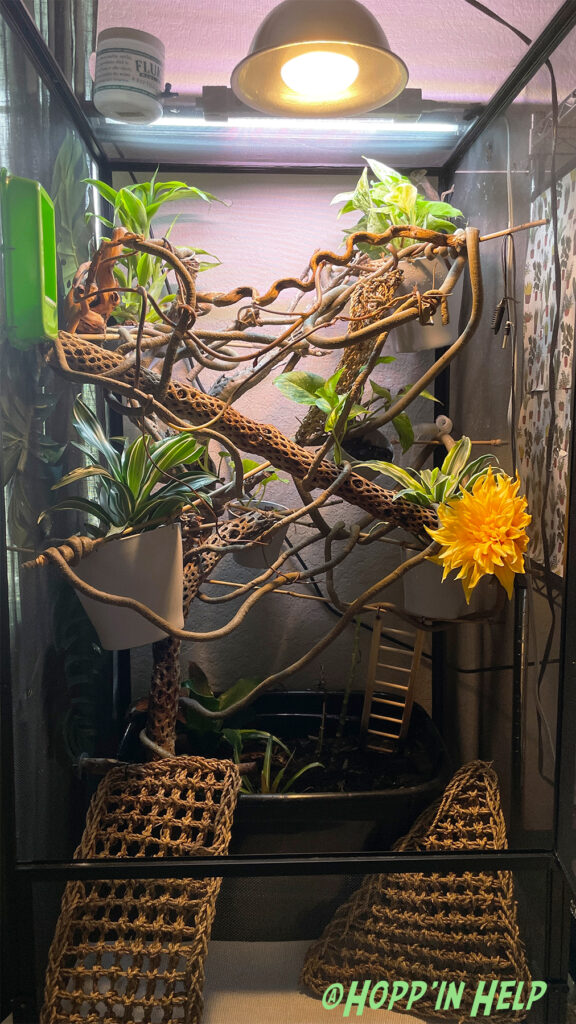
FOR FEMALES: Females require a lay bin for when they become sexually mature and lay eggs. This will occur with or without the presence of a male. It is crucial that you give the proper environment for your Veiled Chameleon to lay her eggs. They can become egg bound in under 24 hours a die from the complications. I suggest setting up a dig bin when you adopt your chameleon not matter the age. This will ensure it is available whenever your chameleon needs it and she will be comfortable around it. I had a custom container made to sit perfectly into the bottom of the Reptibreeze enclosure. Plastic bins deep litter boxes also work perfectly. The bin should be at least 5-10inches depending on the size of your chameleon. I personally use Zoo Med Reptisoil because it is the perfect pre-made mixture, but you may create your own substrate. A blend of 3/4ths part soil (soil without fertilizer or coconut fiber substrate) and 1/4ths part sterilized play sand. Mix thoroughly until even. Keep the mixture moist so that it can be “molded’ like a sandcastle but a cave for the eggs.
How to Sterilize Play Sand: Begin by placing the sand needed in a large bucket/bowl. Pour boiling water carefully into the container and stir until the sand is submerged. Allow to sit for around 5 minutes and then drain the sand. Repeat this process if the sand is still dirty after draining. Place sand on a baking sheet and dab with paper towels. Give sand time to thoroughly dry out. Bake sand in the oven at 180 degrees F (82 C) for 30 minutes and then your sand is sterilized. Be sure to allow plenty of time for the sand to cool and break down any clumps.
Plants for a Dig/Lay Bin: Some female Veiled Chameleons prefer to dig into the roots of a plant to lay their eggs. Umbrella Plant, Weeping Fig, and hibiscus trees make perfect plants to place in the dig bin. The leaves serve as cover, the roots support their tunnel, and the branches give your chameleon a way to get up and down from the bin.
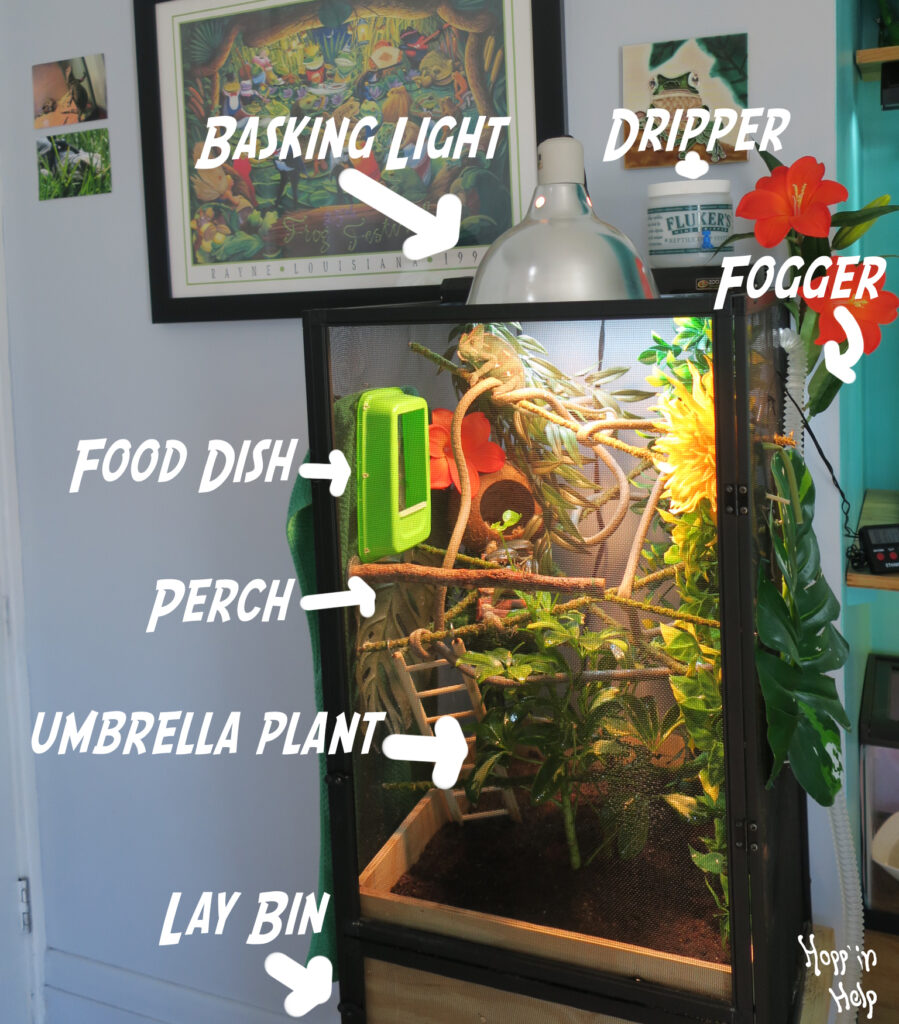
TEMPERATURE: Day time temperatures of 70-75 degrees F (21-24 C) are ideal. A basking spot of around 85 degrees F is needed. A 65 Watt BR30 incandescent Indoor Floodlight is suggested for your basking light.
Night time temperatures should stay around 50-58 degrees F (10-15 C). New research has surfaced by Bill Strand that cold nights are needed for deep sleep! Which in turn leads to a healthy, long living chameleon. No supplementary heat is needed.
UVB LIGHTING: UVB light is a necessity. UVB is your chameleon’s source of vitamin D3, which is crucial to your chameleon’s overall health. A Zoo Med Reptisun T5 5.0 Linear UVB bulb is the proper light. Purchase a hood and fitting bulb that is the length of the top of your enclosure.
Branches should be placed at least 6 inches (15cm) below the UVB as the first few inches of light are very strong.
There has been new research surfacing regarding the proper strength of UVB bulbs (whether 5.0 that is “weaker” or 10.0 that is far stronger). After consulting my personal Exotic Vet who has many years of experience with Chameleons, she still suggests 5.0. A 10.0 UVB bulb used incorrectly can cause severe burns and can be easily avoided by using a 5.0 bulb that mimics filtered sunlight through tree canopies more appropriately.
FEEDING: Veiled Chameleons are omnivores but predominantly eat insects. This should be reflected in your feeding routine. Veiled Chameleons typically receive their plant material intake from snacking on the plants in their enclosures. This is why it is important to review which plants you place in your enclosure and avoid plastic foliage. Crickets and roaches should be the main diet of chameleons of all ages.
How much to feed your Veiled Chameleon based on their age:
- 0-5 Months Old: 10-20 small crickets or dubia roaches everyday. Pinhead crickets would be the best for a hatchling. During this time your Veiled chameleon is growing the most so they will need the most food! I personally suggest feeding the insects one at a time to give your chameleon the opportunity to swallow their food between “bites”. This will prevent a blockage. Continue to feed until they are no longer interested or reach 20 insects.
- 6-11 Months Old: 6-10 medium sized crickets or dubia roaches every day. During this time your chameleon will continue to grow but not at the same high rate as before. Begin to slow down on the quantity feed each day. For example, at 6 months old, feed 10-12 crickets, at 7 months feed 8-10, 8 months feed 6-8 etc.
- 1 Year Old: 5-7 large crickets Monday, Wednesday, Friday. At this point your Veiled chameleon has begun to slow down greatly in terms of growth. Over feeding can lead to obesity which strains their gentle bones. The first signs of your Veiled Chameleon is becoming over weight is through neck. Fat will begin to store there as pictured below. This is a sign to feed less feeders.
- 2+ Years Old: All Veiled Chameleons are different and require different needs. Many owners begin to only feed every few days or so with 3-4 large insects. There is no exact science to it. As their care giver you need to understand their bodily needs and make the best feeding choices for them!
- ALL AGES: It is important to keep in mind that a diverse diet makes a healthy chameleon! Listed below are snacks that can be given alongside daily meals.
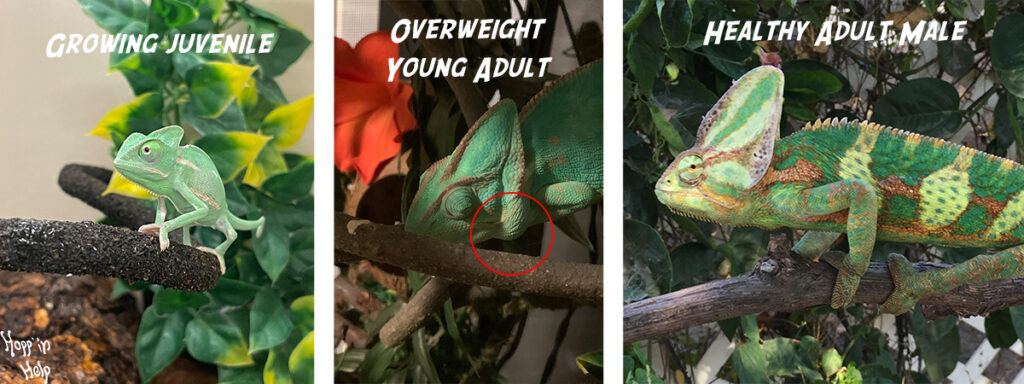
- Crickets & Dubia Roaches: Main Diet, feed according to age listed above.
- Meal/Super Worms: Have hard chitin shells making them difficult to digest. These should only be given periodically to prevent impaction.
- Horn Worms: High in moisture, a great way to keep a chameleon hydrated. Do not feed extremely large worms, worm should be no thicker than space between the chameleon’s eyes. Can be feed about once a week. Great for hydrating females as they prepare to lay eggs.
- Locust & Moths: Great activity to allow your chameleon to hunt them in their enclosure, can be feed supplementally to their main diet often.
- Black Soldier Fly Larvae: Can be feed regularly and are high in calcium, no need to dust them!
- Wax Worms: Extremely high in fat, should only feed as meal about once or twice month. Great supplementary food next to their main diet for malnourished rescued Veiled Chameleons.
What size crickets or dubias do I get for my Veiled Chameleon? A general rule for feeding Reptiles and Amphibians is, the food in question’s girth should fit in between the animal’s eyes. Too large of food can harm your chameleon as it begins to swallow. Medium-sized feeds are in general the perfect size for all chameleons.
Gut Loading Feeder Insects: Gut loaded feeders are insects that are extremely healthy and packed with important vitamins for your chameleon. You will first need a place to keep your feeders. I keep thousands of crickets at a time in a utility tub with the drain sealed closed. I prefer this because it is easy to clean and move. I then use an old window screen to cover the lid. Aquarium tanks and bins with proper airflow also work well for feeder bins. Then feed your feeder insects fresh vegetables and fruits. Do not allow the food to mold, henceforth remove the food after 1-2 days.
Feed the insects:
- Dark Leafy Greens
- Squash, Potatoes, & Carrots
- Oranges and Apples
- Whole Wheat Breads & Grains
SUPPLEMENTS: It is extremely important to then dust your main feeders with calcium powder every feeding. This every meal calcium powder should not include vitamin D3. While this is an extremely important vitamin, with proper UV lighting, your chameleon will produce the needed amount on their own. Too much D3 can become toxic and harm your chameleon. It is suggested to give calcium WITH D3 twice a month to boost levels.
Multivitamins are also an extremely important piece of your Veiled Chameleons health. This acts the same for chameleons as it does for humans. It gives a general boost of beneficial minerals and vitamins that help their overall health. A multivitamin should be given TWICE MONTHLY. Simply dust the feeders in the multivitamin, do not place calcium on the feeders when giving the multivitamin, and then feed your chameleon!
Listed below is a chart of the best calciums and multivitamins. I am currently using Zoo Meds Repti Calcium & Repashy Calcium Plus. I give my multivitamin the first and third Friday, and D3 calcium the second and fourth Friday of every month.

METABOLIC BONE DISEASE: One of the most common issues chameleons face in captivity is Metabolic Bone Disease. This is a result of improper husbandry, diet and failure to provide proper nutrients. The lighting and feeding instructions above are crucial to your chameleon’s well-being.
Chameleons require calcium which strengthens their bones and contributes to their overall health. Vitamin D3 is created naturally in their body from exposure to UVB light. Vitamin D3 is needed to process the calcium. MBD can be the result of any of these factors not being properly meet. Too little calcium or too high of calcium with no D3 is the leading cause of MBD in Veiled Chameleons. Calcium is an essential nutrient in promoting bone growth, development, and supports proper nerve function. Wild healthy chameleons have a balanced calcium-phosphorus-vitamin D3 ratio that is regulated and maintained by various bodily hormones. In captivity, if there is too much or too little calcium in an animal’s diet, these balances will be disrupted. Once an animal’s normal calcium deposits or reserves are expended, the animal’s bone material will be used to derive their needed levels of calcium, thereby resulting in MBD. Below are photos of Veiled Chameleons suffering from MBD.


DEHYDRATION: Chameleons will only drink water from dripping leaves. You must provide them with a proper way to drink water or they will become severally dehydrated quickly. This is typically irreversible even with vet care. Dehydration is diagnosed by sunken eyes. This can also be a sign of illness and other complications, including a female becoming egg bound. This is when she cannot pass her eggs and they become stuck. Proper access to dripping water and a lay bin prevent this.
If you believe your chameleon is not drinking enough water, fill a syringe with water, place at the base of their mouth and slowly administer water. It may take your chameleon a few attempts to understand how to drink from the syringe but it is very common for chameleons to be comfortable drinking from one. I personally suggest giving your chameleon the option to drink from a syringe regularly to ensure they are getting water each day.
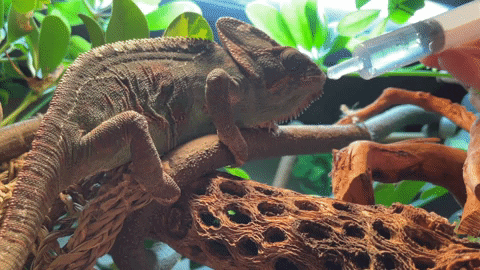

SHEDDING: Unlike most reptiles, soaks are not a part of regular care. It is important to keep the proper humidity because chameleons do not like being submersed in water. Soaks to remove stuck shed should only be done in emergency situations like a rescue. As your chameleon grows, they will shed their skin and flake it into the enclosure. Be sure to clean it up when they are done! You may need to help remove nose shed. Carefully take tweezers and help remove the shed out of the nostril. Do NOT pull shed anywhere else on the body. This can damage the chameleons scales and hurt. Occasional my chameleons gets a “boot” of shed that has fallen off stuck on their foot. I will help place it off but this shed has already fallen off so it is safe to remove.
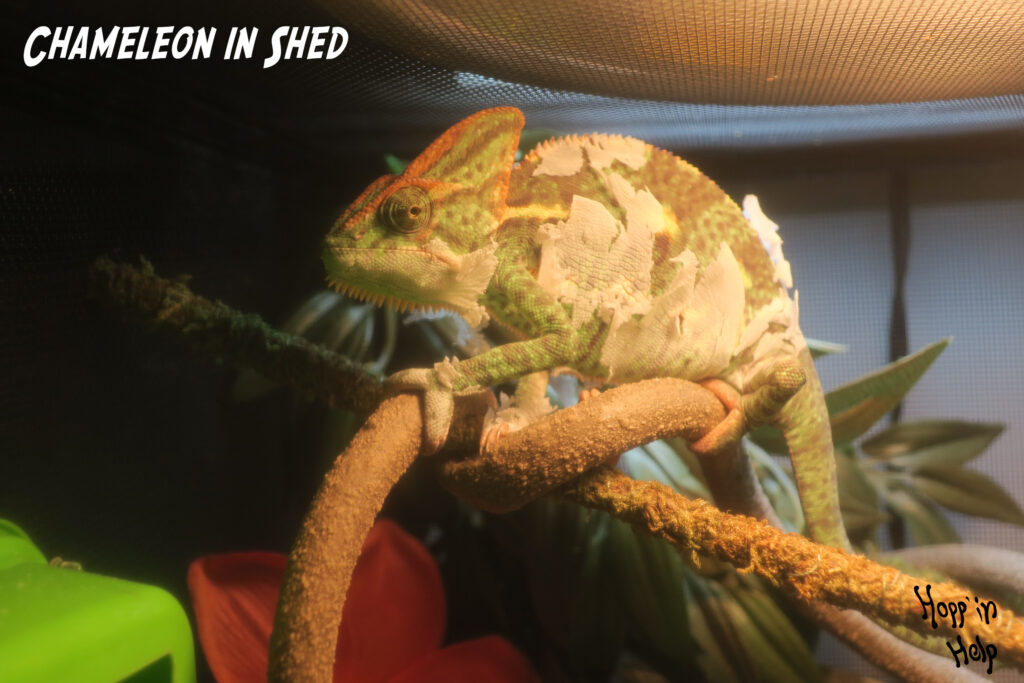
HOW TO SEX: Males have tarsal spurs on the heels of their back feet. It looks almost like a thumb. Males tend to be larger than females with a skinnier body type.
Females lack tarsal spurs. This can be done at any age to determine the sex. Females also tend to be shorter than males with a bulkier body type.
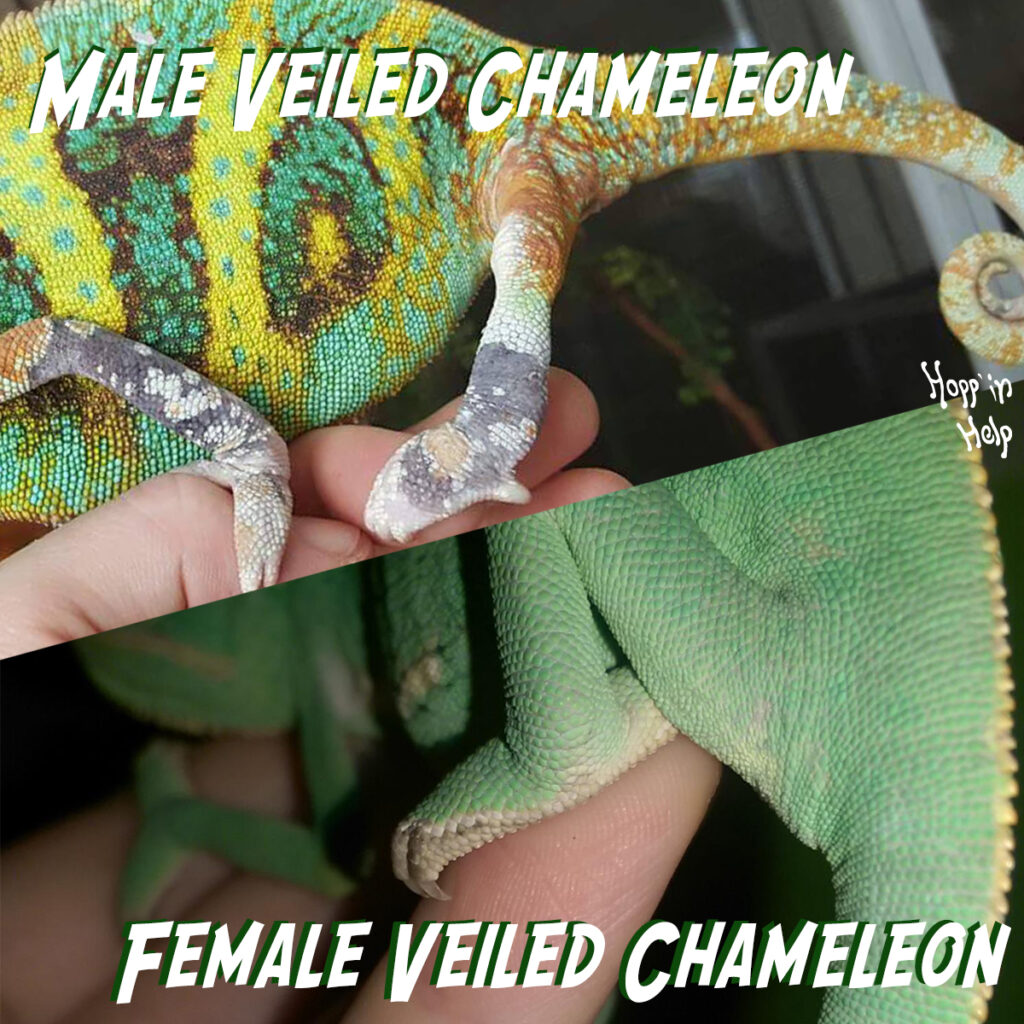
SIZE: As stated above, length is dependent on the sex of the chameleon. Males grow to be 14-18 inches (35-46cm). Where females tend to range from 10-13 inches (25-33cm)
I AM NEW TO REPTILES, ARE THEY GOOD FOR BEGINNERS?
Veiled Chameleons or any Chameleon are only for advanced reptile owners. Chameleons are extremely fragile physically along with their health and wellbeing. Even experienced reptile owners can have a hard time keeping their Veiled Chameleon happy and healthy. I highly suggest a Leopard Gecko for first-time reptile owners, and never suggest a Chameleon for a first time pet in any way.
